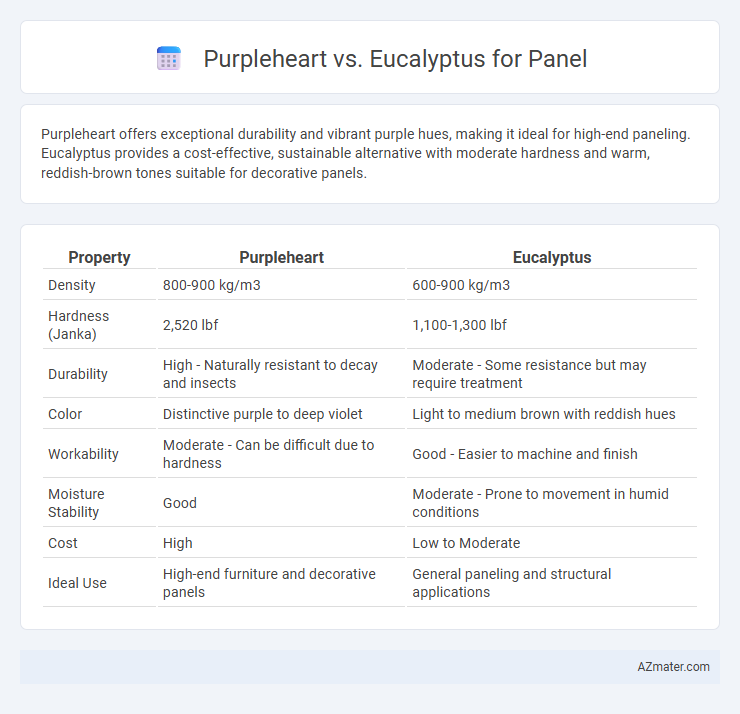Purpleheart offers exceptional durability and vibrant purple hues, making it ideal for high-end paneling. Eucalyptus provides a cost-effective, sustainable alternative with moderate hardness and warm, reddish-brown tones suitable for decorative panels.
Table of Comparison
| Property | Purpleheart | Eucalyptus |
|---|---|---|
| Density | 800-900 kg/m3 | 600-900 kg/m3 |
| Hardness (Janka) | 2,520 lbf | 1,100-1,300 lbf |
| Durability | High - Naturally resistant to decay and insects | Moderate - Some resistance but may require treatment |
| Color | Distinctive purple to deep violet | Light to medium brown with reddish hues |
| Workability | Moderate - Can be difficult due to hardness | Good - Easier to machine and finish |
| Moisture Stability | Good | Moderate - Prone to movement in humid conditions |
| Cost | High | Low to Moderate |
| Ideal Use | High-end furniture and decorative panels | General paneling and structural applications |
Introduction to Purpleheart and Eucalyptus Wood
Purpleheart wood, known for its vibrant purple hue and exceptional durability, is prized in woodworking for its strength and resistance to decay, making it ideal for heavy-use panels. Eucalyptus wood offers a sustainable option with its fast growth and dense grain, providing a sturdy and cost-effective material for paneling projects. Both woods present unique aesthetic and functional qualities, with Purpleheart favored for its striking color and longevity, while Eucalyptus is valued for its environmental benefits and versatility.
Origin and Source of Each Wood
Purpleheart wood is primarily sourced from the Peltogyne genus native to Central and South American rainforests, particularly in countries like Brazil, Guyana, and Suriname, known for its vibrant purple hue and dense grain. Eucalyptus wood, derived from several species within the Eucalyptus genus, originates mainly from Australia, with plantations also established in parts of the United States, Spain, and South Africa, valued for its fast growth and sustainability. The distinct geographical origins influence the wood's hardness, color stability, and working properties, making Purpleheart ideal for exotic, durable paneling and Eucalyptus favored for eco-friendly, versatile applications.
Appearance and Color Differences
Purpleheart wood is distinguished by its vibrant purplish hue that deepens to a rich brown over time, making panels visually striking and unique. In contrast, eucalyptus panels feature a more subdued, creamy to light brown color with subtle grain patterns, offering a consistent and natural look. The stark color contrast between purpleheart's bold, exotic vibrancy and eucalyptus's warm, earthy tones influences design choices for interior or furniture panels.
Durability and Hardness Comparison
Purpleheart wood boasts exceptional durability and hardness with a Janka rating of approximately 2,520, making it highly resistant to wear, decay, and insect damage, ideal for heavy-use panels. Eucalyptus panels, while moderately durable with a Janka hardness ranging from 1,160 to 1,930 depending on the species, generally offer good resistance but fall short of Purpleheart's superior toughness. For applications demanding maximum longevity and surface resilience, Purpleheart outperforms eucalyptus by a significant margin in both hardness and durability metrics.
Workability and Machining Properties
Purpleheart wood exhibits excellent workability with a dense, oily texture that holds cuts cleanly but can dull tools slightly faster than lighter woods. Eucalyptus offers superior machinability due to its moderate density and straight grain, allowing easy shaping and sanding with minimal tool wear. Both woods dry stable, but Purpleheart requires sharp blades and slower feed rates during machining to prevent chipping and heat buildup.
Cost and Availability
Purpleheart wood typically costs more than eucalyptus due to its rarity and exotic import status, making it less accessible for large-scale panel production. Eucalyptus is widely available, particularly in regions like Australia and parts of the US, and offers a more cost-effective option for panels with consistent supply chains. The high demand and limited supply of purpleheart contribute to its premium pricing and occasional stock shortages compared to readily abundant eucalyptus.
Environmental Impact and Sustainability
Purpleheart wood, sourced from trees native to Central and South America, is known for its durability but often requires long-distance transportation, increasing its carbon footprint compared to eucalyptus. Eucalyptus, a fast-growing hardwood primarily cultivated in plantations worldwide, offers a more sustainable option due to its rapid regrowth and lower environmental impact during harvesting. Both woods are durable for panels, but eucalyptus's quicker renewability and locally sourced availability make it a more eco-friendly and sustainable choice for environmentally conscious projects.
Common Applications in Paneling
Purpleheart wood is favored for high-end paneling due to its rich purple hue and exceptional durability, making it ideal for decorative interior walls and custom furniture panels. Eucalyptus, known for its affordability and sustainability, is commonly used in structural panels, wall cladding, and outdoor applications where moisture resistance is important. Both woods offer solid stability and unique aesthetics, but purpleheart is chosen for luxury finishes while eucalyptus is preferred for cost-effective, eco-friendly panel solutions.
Maintenance and Longevity
Purpleheart wood exhibits exceptional durability and resistance to wear, requiring minimal maintenance such as occasional cleaning and oiling to preserve its vibrant color and structural integrity. Eucalyptus panels, while moderately durable, need more regular upkeep including sealing and moisture control to prevent warping and surface degradation. Over time, Purpleheart typically outlasts Eucalyptus in longevity, making it a superior choice for high-traffic or long-term panel installations.
Which Wood Is Best for Your Paneling Project?
Purpleheart wood stands out for paneling projects due to its vibrant purple hue, exceptional durability, and resistance to wear, making it ideal for long-lasting, eye-catching installations. Eucalyptus offers a more affordable and sustainable option, featuring a warm, reddish-brown color and moderate hardness suitable for interior paneling with a natural aesthetic. The best choice for your paneling project depends on whether you prioritize striking visual impact and resilience (Purpleheart) or budget-friendly, eco-conscious materials (Eucalyptus).

Infographic: Purpleheart vs Eucalyptus for Panel
 azmater.com
azmater.com